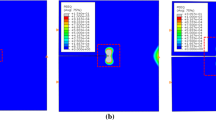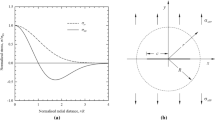Abstract
A finite element model of a plate, which contains an initial crack subjected to a rapid loading at its faces, is investigated. A cell model of the prospective process region is adopted. The cell size is assumed to represent some characteristic intrinsic material length. The size of the process region is not predetermined but depends at every time on the number of cells that have reached a state characteristic for the process region i.e. essentially instability if load control would prevail. Outside the process region the material is assumed to be linearly elastic.
For low loading magnitudes the simulations show a rather long period of crack acceleration, but at higher loads this period is short or even not detectable, and a constant terminal velocity, significantly lower than the Rayleigh wave velocity, is reached. At lower loads both the energy release rate and the extension of the process region stay rather constant, but at higher loads they increase considerably with time, even though the crack tip velocity stays constant. Thus it appears that a tendency towards increased energy flow to the process region is met by increased size of this region, and thereby increased energy dissipation per unit of crack growth, rather than by increased crack edge velocity. The process region may finally occupy several cell rows, and the control of the process region by the characteristic length is thus lost. This can explain the apparent loss of the unique relation between stress intensity factor and crack edge velocity at high crack velocities.
In some simulations branching was obtained. The results from the simulations showed qualitative agreement with some recent experimental results e.g. those by Ravi-Chandar.
Similar content being viewed by others
References
A.A. Griffth, Philosophical Transactions of the Royal Society (London A)221 (1920) 163–198.
G.R. Irwin, Journal of Applied Mechanics 24 (1957) 361–364.
T.L. Paxson and R.A. Lucas, Proceedings of an International Conference on Dynamic Crack Propagation, Lehigh University, Bethlehem, Pennsylvania, USA, Nordhoff International Publishing, Leyden (1972) 415–426.
K.B. Broberg, in High Velocity Deformation of Solids, IUTAM. Tokyo, August 24–27 1977, Springer-verlag, Berlin (1977) 182–194.
K.B. Broberg, in Fundamentals of Deformation and Fracture, Cambridge University Press (1985) 233–242.
K. Ravi-Chandar, Doctoral thesis, California Institute of Technology, Pasadena (1982).
K. Ravi-Chandar and W.G. Knauss, International Journal of Fracture 25 (1984) 247–262.
K. Ravi-Chandar and W.G. Knauss, International Journal of Fracture 26 (1984) 65–80.
K. Ravi-Chandar and W.G. Knauss, International Journal of Fracture 26 (1984) 141–154.
K. Ravi-Chandar and W.G. Knauss, International Journal of Fracture 26 (1984) 189–200.
J.F. Kalthoff, S. Winkler and J. Beinert, International Journal of Fracture 12 (1976) RCR 317–319.
J.F. Kalthoff, in Workshop on Dynamic Fracture, February 17–18, California Institute of Technology (1983) 11–35.
K.B. Broberg, Engineering Fracture Mechanics 16 (1982) 497–515.
L.G. Pärletun, Engineering Fracture Mechanics 11 (1979) 343–358.
T. Belytschko and T. Hughes, Computational Methods for Transient Analysis, Elsevier, Amsterdam (1983).
E. Johnson, Influence of process region characteristics on rapid crack propagation, Report LUTFD2/(TFHF-3043), Solid Mechanics, Lund Institute of Technology, Lund (1991).
Author information
Authors and Affiliations
Rights and permissions
About this article
Cite this article
Johnson, E. Process region changes for rapidly propagating cracks. Int J Fract 55, 47–63 (1992). https://doi.org/10.1007/BF00018032
Received:
Accepted:
Issue Date:
DOI: https://doi.org/10.1007/BF00018032




